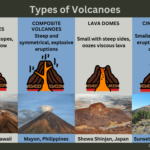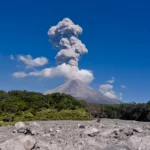Get ready to explore the fiery heartbeat of our planet! We’re diving into the world of igneous rocks, the building blocks of Earth and even the moon. Let’s uncover the incredible story of these mesmerizing geological wonders and their surprising impact on our lives.
5 Facts About Igneous Rocks
Let’s face it, rocks might not be the first thing that pops into your head when you think “exciting,” but trust me on this one. Igneous rocks, born from the heart of volcanoes and ancient, fiery forces, are like Earth’s personal storytellers. They’ve been around since the very beginning, quietly shaping our planet in ways we’re just starting to understand. Intrigued? Let’s dive into five fascinating facts about these geological wonders!
1. The Backbone of Our World:
Imagine a world without solid ground. Can’t do it, right? You can thank igneous rocks for that. A whopping 95% of Earth’s crust, the very foundation we walk on, is made up of these incredible formations. And it’s not just our planet! Our moon also owes its solid structure to these rocky wonders. Talk about holding the universe together!
2. Architects of Mountains and Volcanic Fireworks:
Ever stood in awe of a majestic mountain range? Igneous rocks are the masterminds behind those breathtaking landscapes. When volcanoes erupt, they spew out molten rock called lava. As this lava cools and solidifies, it forms the iconic cone-shaped peaks and dramatic slopes we associate with volcanoes. It’s a fiery, powerful process that reminds us of the incredible forces constantly shaping our world.
3. Hidden Gems and Precious Metals:
Forget buried treasure chests – igneous rocks are nature’s true treasure troves! Deep within their crystalline structures, they harbor a dazzling array of precious materials. Diamonds, shimmering gemstones, valuable metals like gold and silver – they all originate from these geological gifts. It’s no wonder that igneous rocks are highly sought after by industries and collectors alike!
4. Rocks That Float? You Bet!:
You might think of rocks as heavy and dense, and you’d be right for the most part. But there’s a fascinating exception – pumice. This igneous rock is like the rebel of the group, boasting a unique ability to float on water. Its secret? Pumice is packed with tiny air bubbles trapped during its formation from frothy, gas-rich lava. This makes it incredibly lightweight and buoyant, defying our expectations of what a rock should be.
5. Windows into Earth’s Past:
Igneous rocks are like time capsules, preserving clues about Earth’s history for millions, even billions, of years. Scientists study their composition and texture like detectives searching for clues. The type of minerals present, the size of the crystals, even the arrangement of tiny grains – they all reveal secrets about the ancient environments and powerful tectonic forces that shaped our planet. By deciphering these rocky puzzles, we gain a deeper understanding of Earth’s epic journey through time.
Did you know that what’s the most common extrusive igneous rock on earth is basalt? It’s a fine-grained, dark-colored rock that forms when lava cools quickly on the surface of the Earth. And if you’re interested in more fascinating tidbits about igneous rocks, check out our page on igneous rocks fun facts.
How do igneous rocks contribute to Earth’s diverse landscapes and geological formations
These rocks, born from fire, are like the building blocks of our planet. They tell a story of intense heat and pressure, shaping the very ground we walk on. Imagine molten rock, so hot it glows, bursting from the Earth’s core. As it cools and hardens, it transforms into igneous rock, leaving its mark on the landscape.
The speed at which this molten rock cools determines the texture of the rock. A rapid cooldown, like a shock of cold water, results in fine-grained rocks, almost smooth to the touch. But, if the cooling is slow and steady, like a cake baking in the oven, large crystals have time to grow, giving the rock a coarse, almost glittery appearance.
And it’s not just about looks! The ingredients in this molten mix, the minerals and elements present, determine the rock’s composition. From the light-colored, silica-rich granite we often see in countertops to the dark, dense basalt found in volcanic landscapes, each igneous rock has a unique story to tell about its formation.
These rocks are more than just pretty faces. The weathering and erosion of igneous rocks over millions of years release essential nutrients into the soil, feeding the cycle of life. They form the foundation of mountains and valleys, shaping our planet’s breathtaking scenery.
Think of volcanic eruptions – a dramatic display of Earth’s power. These events, driven by igneous activity, birth new landforms right before our eyes. Towering volcanoes, like majestic giants, and serene lava domes, frozen in time, are all testaments to the power of igneous rocks.
And there’s more! These rocks are treasure troves, often hosting valuable mineral resources. Metals we use every day, sparkling gemstones that adorn our jewelry, and durable building materials – all gifts from the heart of igneous rocks. They are a testament to the interconnectedness of our planet, constantly evolving and shaping the world around us.
From Towering Mountains to Expansive Volcanic Plateaus
We’ve explored the fiery heart of volcanoes and their explosive eruptions, but what about the landscapes they sculpt? It’s a dramatic tale of tectonic plates colliding, magma surging upward, and the earth itself reshaping over millennia.
Imagine the immense pressure building as tectonic plates grind against each other. This friction generates incredible heat, melting rock deep within the earth’s mantle and forming magma. Seeking an escape, this molten rock pushes upwards, finding weak points in the Earth’s crust. These weak points, often along the edges of tectonic plates, become the birthplaces of volcanoes.
Think of a spreading center, like the Mid-Atlantic Ridge, where tectonic plates are pulling apart. This creates a rift, a pathway for magma to rise from the depths. As the magma erupts and cools, it forms new crust, slowly building up the ocean floor and sometimes even creating volcanic islands!
Subduction zones offer another dramatic display of tectonic forces. Here, one tectonic plate is forced beneath another, plunging into the Earth’s mantle. This process triggers the melting of rocks, creating magma plumes that ascend and erupt, often forming chains of volcanic mountains along the plate boundary. The Andes Mountains are a stunning example of this process.
But volcanoes aren’t confined to plate boundaries. Deep within the Earth’s mantle, plumes of hot rock, known as mantle plumes, can rise up, punching through the crust like blowtorches. These plumes create hotspots, areas of intense volcanic activity that can persist for millions of years. The Hawaiian Islands, a chain of volcanic peaks in the middle of the Pacific Plate, are a testament to the power of mantle plumes.
The type of rock formed during a volcanic eruption depends on how quickly the lava cools. Lava that erupts onto the surface cools rapidly, forming fine-grained rocks with small crystals, like basalt. But magma that cools slowly deep underground has time to grow larger crystals, resulting in coarse-grained rocks like granite.
Each igneous rock tells a story, a geological snapshot of its formation. By studying these rocks, scientists piece together the history of volcanic activity, tectonic plate movement, and the evolution of our planet’s landscapes. From the jagged peaks of volcanic mountains to the vast plains of volcanic plateaus, these landscapes are a testament to the raw power that lies beneath our feet.
What distinguishes the two main categories: intrusive and extrusive igneous rocks
Key Takeaways:
- Intrusive rocks crystalize beneath the surface, while extrusive rocks crystallize above the surface.
- Intrusive rocks are generally coarse-grained, while extrusive rocks are fine-grained.
- Intrusive rocks are usually more massive, while extrusive rocks may be more vesicular or amygdaloidal.
Picture this: molten rock, known as magma, churning deep within the Earth. It’s a slow, simmering process, like a pot of soup left on low heat. As this underground magma cools, it solidifies and forms what we call intrusive igneous rocks. Because they cool down over a long period, the minerals inside have plenty of time to grow, resulting in a coarse, granular texture – think of it like the difference between coarse salt and fine sugar.
Now, imagine that same hot magma bursting out onto the Earth’s surface, perhaps as a volcanic eruption. Suddenly exposed to the cool air or water, the molten rock cools down much more rapidly. This quick transition doesn’t give the minerals much time to grow, so they form extrusive igneous rocks with a much finer texture. Think smooth, like a polished countertop.
But there’s more to the story than just texture! The environment where these rocks form also plays a major role in their appearance. Intrusive rocks, formed deep underground, tend to be massive and solid. They’ve been protected from the elements and haven’t been broken down by wind and rain. Extrusive rocks, on the other hand, are exposed to the wear and tear of the Earth’s surface. Plus, they often bear the marks of their fiery birth – think of the holes in pumice stones, created by gas bubbles escaping the cooling lava. These holes, called vesicles or amygdales, are a telltale sign of an extrusive origin.
FAQ
Q1: What percentage of Earth’s crust is made up of igneous rocks?
A1: Approximately 95% of Earth’s crust is composed of igneous rocks.
Q2: What are some common minerals found in igneous rocks?
A2: Igneous rocks can contain valuable minerals such as diamonds, geodes, gemstones, and metals.
Q3: How do igneous rocks contribute to plant growth?
A3: Igneous rocks provide essential minerals for plant growth, as they weather and break down.
Q4: How are extrusive and intrusive igneous rocks different?
A4: Extrusive igneous rocks form from lava on the surface, while intrusive igneous rocks form from magma beneath the surface.
Q5: What is a unique property of pumice, an igneous rock?
A5: Pumice is a type of igneous rock that exhibits buoyancy due to its vesicular structure.
- Jesus Bible: Discover Jesus’s Story Throughout Scripture - April 27, 2025
- Don Luis: Unraveling the 16th-Century Virginia Mystery - April 27, 2025
- Captain J’s Kauai Tours: Unforgettable Na Pali Coast Adventures - April 27, 2025
















